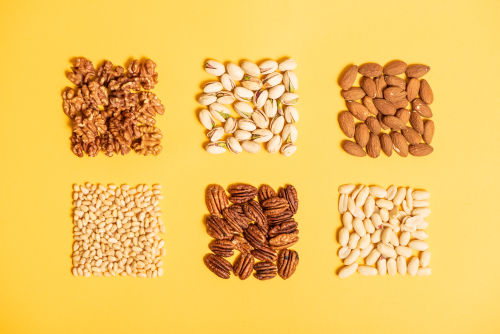Omega-3 and Omega-6 Fatty Acids

You may have heard that omega fats are good for you, but did you know there are different types of omega fatty acids? Keep reading to learn what omega-3 and omega-6 fatty acids are, what foods they’re found in and how they may benefit our health.
What are fatty acids?
There are two general types of fats: unsaturated and saturated. These terms refer to the chemical structure of the fatty acid. Saturated means the fat has no double bonds and unsaturated means there are double bonds. Because of these bonds, unsaturated fats are liquid at room temperature (such as olive oil), whereas saturated fats are solid at room temperature (such as butter).
The terms “omega-3” and “omega-6” refer to the location of the final double bond in the fatty acid chemical structure. The 3 in “omega-3” means the double bond is three atoms away from the end, whereas the 6 in “omega-6” means it is six atoms away.
Omega-3 Fatty Acids
Our bodies do not make omega-3 fatty acids, but we need them for certain functions in our body, therefore they are considered “essential fats”. This means we need to get them from our diet. The Food and Nutrition Board of the Institute of Medicine (IOM) established the adequate intake (AI) for omega-3 fatty acids based on age and gender. Below are the daily intake recommendations:
| Age | Male | Female |
| Birth to 6 months | 0.5 g | 0.5 g |
| 7-12 months | 0.5 g | 0.5 g |
| 1-3 years | 0.7 g | 0.7 g |
| 4-8 years | 0.9 g | 0.9 g |
| 9-13 years | 1.2 g | 1.0 g |
| 14+ years | 1.6 g | 1.1 g |
| Pregnant | 1.4 g | |
| Lactation | 1.3 g |
The Most Common Types of Omega-3 Fats
- Eicosapentaenoic acid (EPA) helps reduce inflammation and may also reduce symptoms of depression.
- Docosahexaenoic acid (DHA) aids in brain development and function.
- Alpha-linolenic acid (ALA) can be converted into EPA and DHA; it benefits the heart, and the immune and nervous systems.

Foods That Contain Omega-3
Nuts and seeds are high in ALA, including flaxseeds, chia seeds and walnuts. Oils such as canola and soybean oil are also good sources of ALA. Fish, including salmon, mackerel, trout and sea bass are good sources of EPA and DHA. The American Heart Association (AHA) recommends eating at least 1-2 servings of seafood per week to reduce the risk of congestive heart failure, coronary heart disease, ischemic stroke and sudden cardiac death. For people with coronary heart disease, the AHA recommends a total consumption of 1 gram per day of EPA and DHA, preferably from oily fish. Fish oil supplements may be considered under the direction of a physician—talk with your doctor if you’re curious about them.
Omega-6 Fatty Acids
Like omega-3 fatty acids, omega-6 fatty acids are essential and must be consumed through diet. However, most people in the U.S. consume excessive amounts of omega-6 fatty acids. The National Institutes of Health set adequate intakes for linoleic acid, a type of omega-6 fatty acid. Below are the daily intake recommendations:
| Age | Male | Female |
| 19-50 | 17 g | 12 g |
| 51+ | 14 g | 11 g |
Foods That Contain Omega-3
Walnuts, pine nuts, sunflower seeds and oil, corn oil, soybean oil, mayonnaise, almonds and tofu are all sources of omega-6 fatty acids. Many processed and fried foods contain corn, cottonseed and soybean oil. A diet high in processed and fried foods can greatly increase omega-6 fatty acid intake.
Omega-6 fatty acids provide energy and contribute to the structure of cell membranes. The body can convert linoleic acid to a longer omega-6 fat called arachidonic acid (AA). AA produces pro-inflammatory molecules that play a key role in the immune system. However, when the body produces too much, it increases the risk of inflammation and inflammatory disease.
Balancing Omega-3 and Omega-6 Fatty Acids
It’s important to balance your intake of these two essential fats so that you can keep your body functioning properly and feel your best. A healthy ratio of omega-6 to omega-3 fatty acids intake is between 1:1 and 4:1. The average American consumes a ratio between 15:1 and 17:1. This ratio can be improved by cutting back on highly processed and fried foods, and eating more foods high in omega-3 fatty acids.
References:
- Omega-3-6-9 Fatty Acids: A Complete Overview. Healthline. Robertson, Ruairi. Updated October 22, 2020. Accessed on June 2, 2022. https://www.healthline.com/nutrition/omega-3-6-9-overview.
- Omega-3 Fatty Acids: Fact Sheet for Health Professionals. National Institutes of Health: Office of Dietary Supplements. Updated on June 2, 2022. Accessed on June 2, 2022. https://ods.od.nih.gov/factsheets/Omega3FattyAcids-HealthProfessional/.
- What to know about omega-6 fatty acids. Medical News Today. Berry, Jennifer and Sullvan, Debra. Written on September 24, 2020. Accessed on June 2, 2022. https://www.medicalnewstoday.com/articles/omega-6-fatty-acids.
Additional Resources and Blog Standard Disclaimer (The following will appear at the end of your post)
Additional Kidney Diet Resources
Visit DaVita.com and explore these diet and nutrition resources:
DaVita Kidney-Friendly Recipes
This article is for informational purposes only and is not a substitute for medical advice or treatment. Consult your physician and dietitian regarding your specific diagnosis, treatment, diet and health questions.

Recent Comments